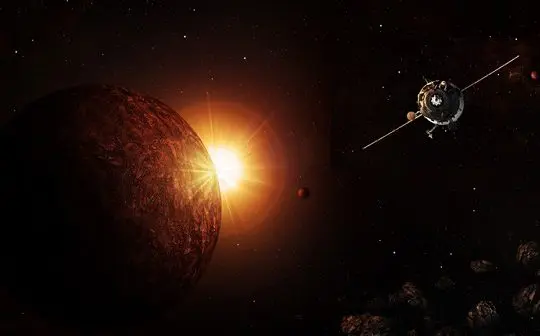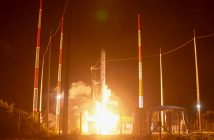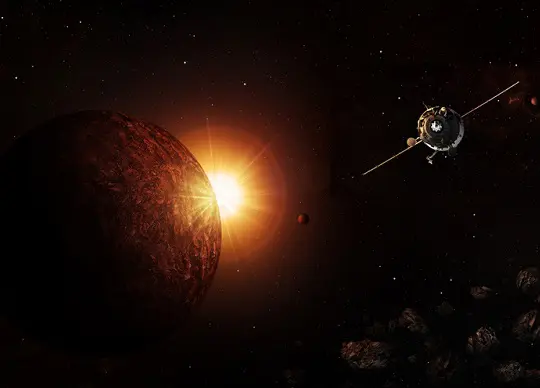
By Chris Flaherty
My Space Warfare Analysis Lab
This concept paper will look at the notion of the Mid-Level Space Power, answering the question – what type of Space Force would it have? The notion of a Mid-Level Space Power, presupposes a hierarchy of Space Powers are emerging in the current century. These entities, can be characterized along two tangents: (1) Either a Space Superpower, Space Power, or Space User; and as well, (2) Characterized by either pursuing Militarization, or Weaponization of Space Strategies.
THE HIERARCHY OF SPACE POWERS
| HIERARCHY OF SPACE POWERS | MILITARIZATION | WEAPONIZATION | |
| SPACE SUPER-POWER | Spacefaring Nation with an advanced Space Industry, and extensive use of Space-Based Infrastructure.
| Satellites support terrestrial military operations. Satellites used for:
Operates Defensive Electronic and Cyber Warfare Capabilities that encompass the Space-Based Infrastructure. | Operates Offensive Warfare Capabilities:
Terrestrial-Based Force capable of attacking:
|
| SPACE POWER | A country with a small scale Space Industry. Builds Space launching rockets. Building its own Space-Based Infrastructure. Maintains a Space Defence Organisation that monitors Space National Interests. | Terrestrial-Based Force Capable of Attacking Space-Based Infrastructure with:
| |
| SPACE USER | Reliant on Allies, and Commercial Partners. Largely uses the existing open-access Space-Based Infrastructure, such as GPS, Internet, and Communications. Likely has a Governmental entity-agency promoting access to Space. |
NO ABILITY |
NO ABILITY |
▲ TABLE 1: Space Powers Hierarchy, and Militarization or Weaponization of Space Strategies.
TABLE 1: The Mid-Level Space Force likely sits, given the examples of others created in the last three years by the non-Superpowers, as a Defence Agency, Regiment, or Squadron level military entity. Framing the creation of a new Mid-Level Space Force is its Historical-Technological Contexts. It is being created in the context of an approximate six-decades into the Space Warfare Age. There are far-more-older Space Forces, that have, or are in the process of a rapid technological transition from Space Warfare concepts dominated by Electronic and Cyber Warfare, and various types of Kinetic Warfare, to Space Manoeuvre Warfare – as these Forces have access to Interplanetary Spacecraft. The key distinction to emerge is a Terrestrial-Based Space Force (a Mid-Level entrant), and a true Interplanetary Space Force. This is also
part of an anticipated process where the Space Forces, belong to a class of Space Superpowers, that convert into Solar System Powers (this prospect is explored at the end of this paper).
At the top of the Space Powers hierarchy are Space Superpowers, dominating the Space Race, since the beginning of the Space Age, following the end of WW2. In the last decade, other entrants to Space, have been able to build Space launching capabilities, and satellite construction, and make military use of Space, accessing the Space Tactical Layer (addressed later in this paper), and likely Space Manoeuvre Layers: Suborbital, Low and Medium Earth Orbits, Cislunar, and Mars Space. This area will also be covered later in this paper.
MILITARIZATION AND WEAPONIZATION OF SPACE
The dynamic of Space Power also divides between opponents who opt for Weaponization over a solely Militarization of Space Strategy. Under current International Space Laws regime, a Space Power opting for its basis of power – the Weaponization of Space, puts it outside the International System, if this is used for non-defensive purposes. This latter development, comes from a largely expanded notion of a ‘Right to Defend in Space’. One of the historical predicaments of the 1967 Outer Space Treaty, was that it did not preclude the Militarization of Space, through broadly banning the stationing of Weapons of Mass Destruction in Outer Space, and prohibition of military activities on celestial bodies (United Nations). This has even seen creation of a legal regime on the International Space Law applicable to military uses of Outer Space in peacetime (Crockett, 2012; McGill, 2016). Since 2020, there has been an exponential increase in the pace of Space activity. Increasing commercial use of Space, has raised the prospect of large numbers of Humans and Robots in Space, and expansive portfolio of Space-Base economic and scientific objects. A real possibility is the need to protect Critical Space-Based Infrastructure. A potentially, massive surge of Human and Robotic activity in Low and Medium Earth Orbits, Cislunar, and Mars Space, will lead to a corresponding transformation in Space Military Technology raising the practical need for a type of patrolling and policing in Space. Potentially this will require using defensive weapons to protect legitimate Space activity, operating in accordance with International Space Laws. Revealing a pattern of constant oscillation between Militarization and Weaponization of Space, which will dominate Space Relations. A further expansion of the concept of legitimate (legal) Weaponization of Space is that of Planetary Defence (discussed at the end of this paper).
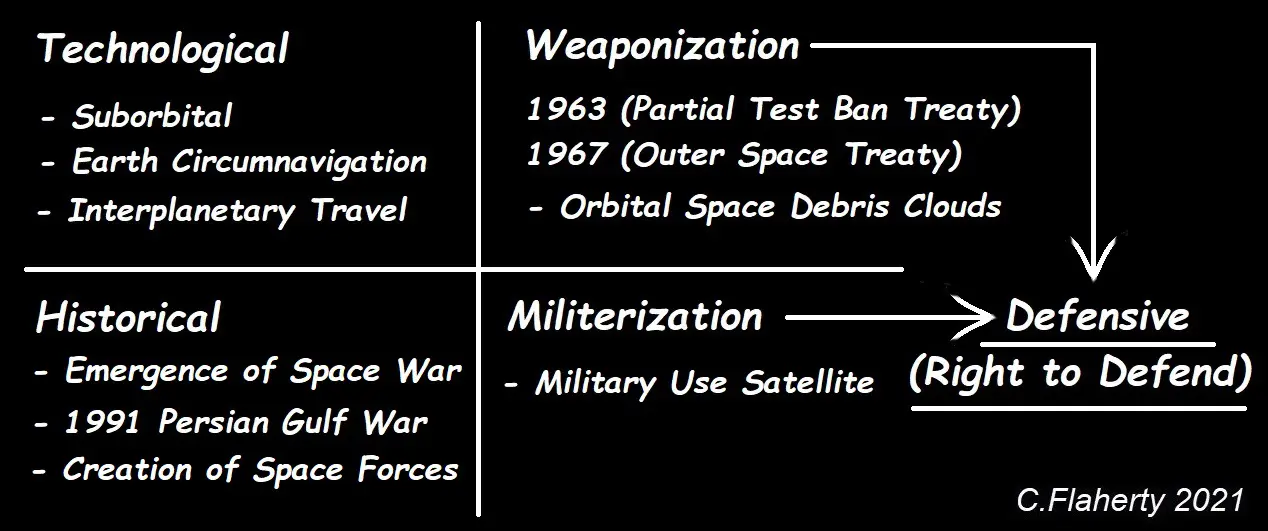
“▲ FIGURE 1: Outlines the four (and a new fifth) set of frames of reference, that largely constrain emergence of a Mid-Level Space Power, namely: (1) Technological, (2) Historical, (3) Weaponization, (4) Militarization, and (5) the Right to Defend.”
FIGURE 1: The scope of this paper will look at a notional Mid-Level Space Force, if created this year. It would sit within a set of four (and a new fifth) frames of reference – these are a specific historical and technological context. If created in the current historical timeframe – given that over the last three years 2019-2021, a number of Space Forces have been created, either belong to one of the Superpowers, or are likely to be classed as Mid-Level Space Forces, several distinctions are beginning to emerge.
This paper will look at four themes: (1) Emergence of Space Forces; (2) The Notional Mid-Level Space Force; (3) Earth’s Satellite Layer; and, (4) Space Manoeuvre. The paper ends with an overview of the likely future direction of Superpower Space Forces, and Planetary Defence. This final part is intended to look at a further framing-constraint on the scope of a Mid-Level Space Force, which will remain largely a Terrestrial-Based entity, in comparison to the likely future shape of the Space Superpowers’ Space Forces, which will radically transform into the dominant military forces of the emerging Solar System Powers, that will operate well beyond the Earth, occupying the Earth’s Moon, Mars, the Asteroid Belt, and several other worlds within the Solar System. This transformation can be anticipated to occur with a coming revolution in Interplanetary Spacecraft construction.
EMERGENCE OF SPACE FORCES
Currently, only the United States has actually established a true independent Space Force as a separate service (2019). Its origins date back to 1982, with the formation of the U.S. Air Force Space Command. So far, the U.S. Space Force, is the only service to conceptualize a Satellite as its current Spacecraft, composing its Space Fleet (U.S. Space Force, 2020). Depending on how a Space Force is defined, among the oldest of the Space Forces, is the VKS (Russian Space Forces), established in 1992 (Federation of American Scientists, 1997). This Space Force, has been responsible for the operation of Cosmodromes, military Space engineering, the Scientific Research Institute on Space Technology, and the Space command, control, and tracking system. Departing from the U.S. and Soviet-Russian examples, a number of other types of Space Forces are known, and each can be situated along a Space Technology Spectrum.
The Aerospace Force: Islamic Revolutionary Guard Corps has developed as a largely strategic missile force (Langton, 2007). It is converting over to Space-launching technology, that in 2020 formally announced itself as a Space Command (Spacewatch Global, 2020). The recent formed United Kingdom Space Command, is a Joint Command staffed from the Royal Navy, British Army, Royal Air Force and the Civil Service (Ministry of Defence). The UK Space Force provides command and control of all its nation’s Defence Space Capabilities, including the UK Space Operations Centre, SKYNET Satellite Communications, RAF Fylingdales: radar base. The UK Space Force – Command, is also part of the Ballistic Missile Early Warning System, and other enabling capabilities within the United Kingdom’s Defence Capability Portfolio. In the case of Japan, its Space Operations Squadron, is part of the Air Self-Defense Force. Its role is mainly to monitor and protect Japanese satellites from enemy attacks or Space debris (Yamaguchi, 2020). The Japanese Squadron, will also conduct satellite-based navigation and communications for other troops in the field.
| SUBORBITAL SPACE WARFARE | USING EARTH’S SATELLITE LAYER | SPACE MANOEUVRE | |||
| Strategic Missile Force | Ballistic Missile Early Warning System | Satellite-Based Navigation and Communications Support | Protecting National Satellites | Controlling Space Launch Capabilities | Operating a Fleet of Satellite-Spacecraft |
▲ TABLE 2: Space Force’s roles and functions along a Technology Spectrum.
TABLE 2: As can be seen from these few examples: Iranian, United Kingdom, and Japanese, that can be currently characterized as Mid-Level Space Forces, these all play a number of roles and functions in relation to Space. These also potentially fall into a dynamic range of Militarized, and Weaponized Technology Spectrum, that also falls into three broad categories of activity: Suborbital Space Warfare, Using Earth’s Satellite Layer, and Space Manoeuvre.
Beginning with the start of the Space Warfare Age, the utilization of the Suborbital Layer above the Earth’s Surface, became synonymous with the passage of an Intercontinental Ballistic Missile. The counter-force for this was Early Warning. The technology spectrum also reflects an historical transition, and transformation, in tactical-strategic weapons technology and thinking following WW2, where the Superpowers and their Allies, built increasingly complex and sophisticated Strategic Missile Forces, and Early Warning Systems. These systems largely dominated the original Suborbital layer above the surface of the Earth.
The notion of Earth circumnavigation entered into tactical-strategic thinking, in the mid-to-late 1950s, with the growing use of satellite surveillance, and until it was banned by a regime of international treaties, the notion of a Spaceplane-Bomber, or an Orbital Battle Station. Even though one did exist in direct contravention of the existing treaties: the Soviet Cannon Armed Salyut-3: OPS-2 (Almaz-2), around 1975. This trend continued after 1975, with the Soviet Rocket Armed OPS-4, and Polyus Laser (that were not launched). Since the early 1990s, the Earth’s Satellite Layer (discussed later in this paper) emerged, and its military use led to the well-known declaration by Air Force Chief of Staff Merrill A. ‘Tony’ McPeak that the Persian Gulf War had been, “the first Space war.” (Bruger, 1995) Use of Space-Based Infrastructure that carries communications, navigational and surveillance capabilities, has largely solidified the concept of occupying the Space High-Ground; as it was originally conceived in the early-to-mid 1950s (Boushey, 1958; Sambaluk, 2011); and which still has the same currency:
“Space has been characterized as ‘the ultimate high ground.’ Orbiting the Earth in 90 minutes … [Low Earth Orbit] … satellites have fields of view spanning hundreds of miles. Geosynchronous Earth Orbit … satellites can view 42% of the Earth’s surface area. Space affords a global vantage point from which to assess large swaths of the land, oceans, and air for strategic-, operational-, and tactical-level applications.” (Joint Publication 3-14)
The question of the roles and functions, and where along a technology spectrum does a notional Mid-Level Space Force sit, will be addressed in the next portion of this paper.
THE NOTIONAL MID-LEVEL SPACE FORCE
A notional Mid-Level Space Force effectively sits within two historical-technological frames of reference:
(1) Military use of the Space Infrastructure is well established, and now some three-to-four decades old; and,
(2) It is also a form of conflict that has been largely defined by Electronic and Cyber Warfare Concepts.
From the perspective of the Mid-Level Space Force, its primary military role will continue to operate in the Electronic and Cyber Warfare fields, focused on protecting its nation’s access to its Space-Based Infrastructure; that in all likelihood, will start to fall under various National Security concepts of National Critical Infrastructure. However, the pace of Space technology in the last decade is beginning a new set of possibilities, in the realm of Space Manoeuvre, that even a largely Terrestrial-Based, Mid-Level Space Force can exploit.
Space Manoeuvre from the perspective of a traditional Space Superpower, has been historically established by its ability to send Spacecraft, with Humans, or Robots to other Planets and Moons in the Solar System. In the case of the Mid-Level Space Force, it will likely begin as a Terrestrial-Based entity, operating from the ground, sea or airspace in support of its own military forces, not unlike a current Land-Based Air Defence Regiment. Its national Space Industry may be nascent. It may be developing the capacity to launch a rocket in Suborbital or Low Earth Orbit, and place a micro-satellite. The capacity to build a rocket, does not necessarily mean a large-scale vehicle capable of multi-ton lifts. A new generation of micro, and small rockets, nine to some 25 metres tall, that can carry a few satellites at a time, with a payload capacity of one, up to 500 kilograms into Low Earth Orbit are increasingly available. Launching these rockets can have a high level of mobility. A small rocket-vehicle delivering small payloads into Suborbital and Low Earth Orbit can be fired from a truck flatbed. The same mobility can be transferred to a ship for vertical launching, or aircraft using horizontal launch (air launch to orbit) technology, taking-off from an airport. It is anticipated, the same technology will be able to launch a Spaceplane, to access Space, that can return-land on a standard airport runway. Mobility and Space Manoeuvre will be discussed next.
SPACE WARFARE CONCEPTS
Notionally, Space Warfare is largely dominated by Electronic and Cyber Warfare Concepts, that has rapidly expanded into the Earth’s Satellite Layer (discussed next in this paper) following the 1991 Persian Gulf War. That saw, the United States make first major use of Military-use satellites to support ground, and air-based manoeuvre. This advancement, has since seen an upswing in weapons technology to destroy, capture or deny satellite access to an opponent. It can also be argued a new form of Space Warfare Manoeuvre is rapidly emerging. The U.S. Space Force, now sees greater orbital manoeuvre possibilities for its fleet of ground-controlled Spaceships-Satellites being able to change orbits (within their Delta-V limitations – how much fuel is carried). Other developments, have been kill-vehicle technology: ground-launched, or larger carrier satellites, that can deploy others; anti-satellite missiles (ASATs); and, ground-based laser batteries. The next major frontier is the rapid domination of the immediate tactical layer of Space. The latter, a zone of Space above the conventional battlefield, will likely see development of mobile ground launch batteries of small-payload rockets (that are reusable) that can put into Suborbital, and Low Earth Orbit a constellation of micro-satellites, to direct terrestrial forces, and jam-deny-spoof opposition satellites. For instance, in the case of the U.S. Space Force:
“Among its major capabilities, the Space Force needs the ability to quickly launch payloads into their desired orbits and Starship could play an important role in performing that mission. But that need can also be met better by other systems. Recently, the Space Force demonstrated its ability to rapidly put satellites into orbit by using the air-launched Pegasus rocket. That rocket has a critical advantage over Starship: While Starship can currently only launch from two locations – Boca Chica, Texas, and Cape Canaveral, Florida – Pegasus can already be launched from a number of locations worldwide.” (Reesman, 2021)
The ability to ‘grab’ immediate tactical dominance utilizing micro- to small rockets, that can launch a range of satellites ranging in classes, from CubeSats to the under 500 kilogram class, from any location on the Earth’s surface using mobile launch capabilities: air-launch, sea-launch, truck flatbeds, and Stratospheric Balloon – Rockoon (rocket and balloon), a Mid-Level Space Force is not precluded from accessing Militarized Space. It can operate Defensive Electronic and Cyber Warfare Capabilities, and protect its Space-Based Infrastructure, or rapid-
build new infrastructure that is operational or campaign specific. Significantly, both a Mid-Level, and Superpower’s Space Forces can share the same scale-of-effort in this respect. A major asymmetric threat is the ability of a Mid-Level Space Force developing Space Weaponization capabilities. These are likely to fall into the same kinetic – non-kinetic range of weapons options (Harrison, 2021). However, rather than pursue Satellite-Based options, like a Space Superpower’s Space Force, the likely demarcation, will be greater access to ASATs. Semi-mobile surface based Laser battery to dazzle and blind an overhead satellite will also be seen as a likely option for the Mid-Level Space Force.
It is theoretically possible, to control a favoured orbit – simply by filling it with a large number of your own satellites: this constitutes a defacto occupation of a portion of Space. We also have emergence of a concept of micro-tactical support satellites, launched from mobile land and sea batteries, by small rockets able to reach Suborbital and Low Earth Orbit to immediately support a tactical operation – this will be looked at next in the context of Earth’s Satellite Layer.
EARTH’S SATELLITE LAYER
The Earth’s Satellite Layer is an artificial piece of Space geography. Currently, a considerable problem, its composition of crowded orbits increasingly cluttered with dead and defunct craft, and debris; that is expected to increase its density dramatically this Century taking-on many of the characteristics of a natural-formed accretion disk, such as Saturn’s rings.
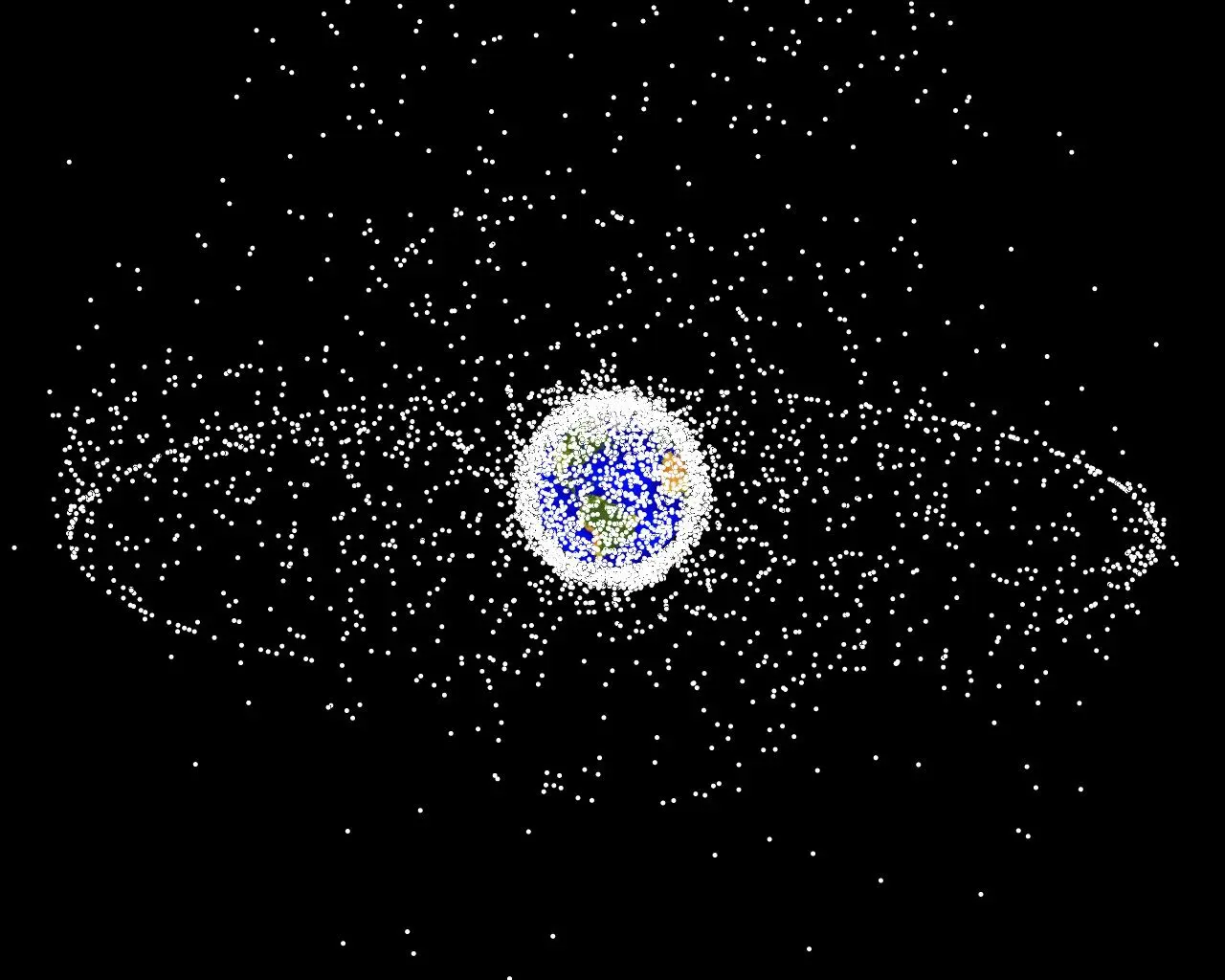
“▲ FIGURE 2: The greatest orbital debris populations exist mainly in the Geosynchronous region, and concentrated in the Northern Hemisphere (NASA, 2005).”
FIGURE 2: The Earth’s Satellite Layer is an artificial layer of Human-made materials that visibly orbit our Planet. Approximately 95% of the objects are orbital debris: not functional satellites. The Satellite Layer can be notionally treated as a type of artificial Space geography, which is an extension of the much broader notion of, “treating the Space environment as just another geography.” (Dolman, 2002) Space geography consists of gravity, orbits, military lanes and lines. It can be viewed from two perspectives: the perspective from Earth’s Surface, and the perspective from a point in Space,
“[that]… emphasizes orbits, regions of Space, and launch points as geopolitically vital assets over which states can be expected competitively and strategically to struggle for control.” (Havercroft, 2009)
As a strategically competitive layer in Space, the Satellite Layer as a piece of artificial geography is composed of objects, and also clutter; and that clutter, places restrictions on potential orbital dynamics. This tactical-strategic notion has been recently expressed in terms of, “the concept of inhibiting movement needs to be perceived through the lens of orbital dynamics.” (Betar, 2021) The significance of this relationship in relation to Space Manoeuvre, is largely one of inhibited and restricted options. The concept of Space Manoeuvre will be looked at next.
SPACE MANOEUVRE
Space Manoeuvre has two elements in relation to the Satellite Layer: (1) Terrestrial Manoeuvre in relation to Space i.e. putting yourself in a good position to launch; and, (2) Manoeuvre in orbit – which is constrained by how an object moves in Space. It is in orbit, but must also expend energy to move – avoid, rotate, slow, that is constrained by a crafts’ Delta-V. The final element of Space Manoeuvre (its Third Axis) is that we are on a Planet itself rotating on its axis, and there is a relationship between an orbiting object, and a point on the Terrestrial Surface – it comes into view, and moves from view. This brings into consideration the concept of two spherical planes constantly rotating, one rotating within another. As well, the outer sphere has a defined geography: the Earth’s Satellite Layer, that has a set of constraints – orbits are crowded-out, others are dominated etc. Orbital crowding largely constrains manoeuvre opportunities within an orbit, or moving to another one, in the case of rendezvous and proximity operations between craft in Space (Samson, 2021). One of the significant problems faced by a Space Force, would be dealing with kinetic Earth-to-Space weapons, as these can produce debris that can affect the safe operation of other satellites in affected orbits (Harrison, 2021).
The ability to achieve Space Manoeuvre in relation to a Terrestrial-Based Space Force, is expressed in terms of the capacity to launch a tactical level satellite. Whereas, in the case of a true Space-Based Space Force, that operates a Space Fleet of Spacecraft-Satellites, Human or Robotically crewed Spaceplanes, Orbital Battle Stations or Interplanetary Spacecraft, then Space Manoeuvre is defined in terms of the ability to harness orbital flight-paths. At the current level of technology, an orbit-shift of a Spacecraft-Satellite is subject to the limitations imposed by time, as it can require deliberate planning, manoeuvring for days, if not weeks or months, beforehand to get into position to have meaningful operational effects (Reesman, 2020). The central notion is that manoeuvre undertaken by a Space Force, occurs in each of the three Space-System Segments: Space, Link, and Ground (Joint Publication 3-14). In the context of Space Manoeuvring,
“[it]… involves the movement of a Spacecraft from one orbit with its inherent characteristics (period, shape, orientation) to another unique orbit.” (Joint Publication 3-14)
In the case of a Mid-Level Space Force, its ability to fully exploit Space Manoeuvre may be significantly lesser, than a more advance Space Force, that operates Spacecraft-Satellites, as these vehicles have already been designed with a much greater Delta-V capacity, than say a micro-satellite launched into the immediate Space above, in order to achieve rapid tactical advantage, such as gaining deeper area sensing, rapid targeting and battlefield situational awareness. Notionally called – the Tactical Space Layer, technology projects such as these are seeking to vastly improve: positioning, navigation and timing, through accessing satellites in Low Earth Orbit to give a soldier located on the Ground Segment dedicated surveillance, navigation and imaging capabilities that can enable long range precision fires and ground manoeuvres in GPS-challenged environment; that is to say where access to GPS may be denied (Erwin, 2021).
As a basic proposition if you, “recognise Space as a full operational Warfighting Domain” (U.S. Space Force, 2020; Davis, 2021), this plays-out very differently, as technology changes the emphasis between Space and Ground Segments. The question, for a Mid-Level Space Force – is how it will operate in Space? In regards to the problem of achieving Space Manoeuvre, this in relation to the Ground Segment, refers to Terrestrial-Based units communicating with satellites and to other Space forces, that are essentially:
“deployable mobile systems and alternate backup locations provide redundancy by moving to geographically dispersed locations, should primary locations become disabled.” (Joint Publication 3-14)
The greater emphasis placed on the Ground Segment, is a direct consequence of the lack of access to larger and more manoeuvrable satellite technology, and the launching capability to put heavier payloads in Space. It should also be noted, that as the more advanced Space Forces increase their access to Space, the notion of greater-unlimited Spacecraft-Satellite refuelling-replenishing Delta-V capacity, and hence manoeuvrability in Space becomes a reality. The emphasis in the case of a true Space-Based Space Force, is the Space Segment, over the Ground Segment.
The argument that can be made, is that as a Mid-Level Space Force would almost be completely Terrestrial-Based, then in terms of its understanding of Space Manoeuvre, and how this is tactically-strategically exploited, the main emphasis is on that force having the greatest land, sea and air manoeuvre capacity possible, in order to survive on an increasingly lethal battlefield. It also means that a Mid-Level Space Force, would likely have a quite different appearance from a more advanced Space Force, that is developing into a military that actually exists in Space, rather than being a conglomerate of traditional Air Force, Navy and Army personnel, using land, sea and aircraft operating across the traditional domains. This is one possible outcome, in relation to a comparison between the U.S. Space Force, which is still on an evolutionary path, evolving to the point that it is an independent, from the United States Army, Navy, or its Air Force, and the Australian Defence Force’s proposed Space Command, that is anticipated, “will bring together the three military branches, along with civilian representatives from Defence, and potentially other government agencies” (Davis, 2021). As was noted earlier, this represents an almost identical evolution to that of the UK Space Force, and Japanese Squadron organisations that have arisen recently.
In relation to Space Manoeuvre, as we might envisage its application by a Terrestrial-Based, Mid-Level Space Force, the capacity to make additional launches are subject to other notional constraints, such as: optimal positions and time-space phasing; or, critical orbits, launch corridors, and communications paths around the world (Szymanski, 2019). Space Manoeuvre constraints would also sit within an overall framework of access to Space denial to the adversary, and maximizing freedom of action (Szymanski, 2019; U.S. Space Force, 2020).
FUTURE DIRECTION OF SUPERPOWER SPACE FORCES
Outside the framework of the Mid-Level Space Power, and its Force, the Space Superpowers are expected over the next decade to hyper-extend their lead over the rest of the Terrestrial Countries. It is expected that the current Spacefaring Nations will rapidly technologically develop, and will have Space Stations, and Human, and Robotic settlement-bases on the Moon, and Mars. Transition to a Space Force, is anticipated to radically change defence budgets, and will have radically different outcomes depending on the entry level. In 2019, military expenditure by the United States amounted to over three-percent of its Gross Domestic Product, amounting to $732 Billion USD (Szmigiera, 2021). It has been calculated in early 2020, in order to get into Space first, around one percent of Global GDP needs to be spent (Air Force Association, 2020). Based on the 2019 total in International Dollars, one percent of Global GDP is about $1.4 Trillion, at current estimates (Statista). It is suggested, however, that more realistically, the spend of one percent of GDP is more likely to be per country – given the initial out-lays likely required for a radical and massive move to create the infrastructure needed for the new Space Economy. It could be anticipated, conversion of the current Space Superpowers, from a terrestrial focus on the Earth, will rapidly convert to Solar System Powers, and military budgets for use on Earth, will likely radically flip – following the complexity inversion equation (Gould, 1978), from investment in surface, sub-surface and air forces, to the majority of the budgets used for building defence capabilities in Space.
A partial driver, of the flip from majority investment in Terrestrial-Based, to Space-Based Space Force, will be that the residual legacy Terrestrial-Based Force will be so massively advanced, that a relatively moderate one, backed by a powerful third boxer coming-in from the deep recesses of Space (Flaherty, 2021), will in all likelihood be capable of overwhelming an opponent with a traditional Terrestrial-Based Force. A powerful capability that will drive Terrestrial-Based campaigns, and global-battlefield manoeuvre will be the development of a new generation of Starlifter-Globemaster: Earth-to-Earth Rocket Transporters, capable of launch and controlled landing single stage rocket transport vehicles. Able to heavy lift hundred ton cargos, or 100 or more Human and Robotic combatants, within one hour over most of the Earth’s habitable land terrain utilising urban infrastructure, and sea-based transports as landing places. The ability to control from Space the high-ground, and circumnavigate the Earth, while the oldest of our Space Warfare concepts, are nevertheless still current. It will make the Space Force, of the future, the true inheritors of the motto of The Royal Artillery: Ubique Quo Fas et Gloria Ducunt (Everywhere Whither Right and Glory Lead).
Another possible direction of future Space Forces, could be less military, and more likely to develop as policing and civil defence entities: Space Coast Guards. This evolution, could be a likely extension of factors, such as Moon, and Mars settlement-bases under civil, and private corporation management, operating within a system of International Space Law, Nation of Flag Registry, and under international auspices. This may see Space Forces used as policing, emergency and civil defence organisations, and largely dedicated to Planetary Defence.
PLANETARY DEFENCE
Assuming, that global international detente holds sway, Militarization and Weaponization of Space will likely continue along a discrete path, developed only for policing, and Planetary Defence, against external threats to Earth, the Moon, or Mars. One of the key planetary threats, is a collision involving a Space Object. It could be anticipated that a series of Deep Space Defence Stations could be constructed, located at any, or all of the several known strategic Lagrange Points. An Asteroid-Based Battle Station has also been proposed at the Jupiter Trojans (Maccone, 2002). Heavily armoured, and armed Battle Stations would likely have rotating rings creating artificial gravity. These might not be that large, as the Von Braun Wheel Space Station was envisaged to be 63 meters: 200 feet in diameter (Neufeld, 2006). Even larger rotating Wheel Stations were only envisaged with a diameter of 76 meters: 250 feet. Envisaged having a three deck wheel revolving at three revolutions-per-minute, to provide artificial one-third gravity, for a crew of 80. A future generation of the Deep Space Defence Stations, could be envisage acting as key transit points for Deep Solar System exploration, and economic activity. Operating as key defence installations, for Civil Space Emergencies, and defending Earth, Cislunar and Mars Space from Deep Space threats. Docking and crew-rest facilities can be imagined. Surfaced armoured to withstand strikes from meteorite, and Space debris. Armed with lasers, and kinetic kill vehicles, launched from it (Janhunen, 2021). It would carry asteroid and meteor killer weaponry, or capabilities to capture and recover these – not unlike the current planned NASA’s Asteroid Redirect Mission (NASA).
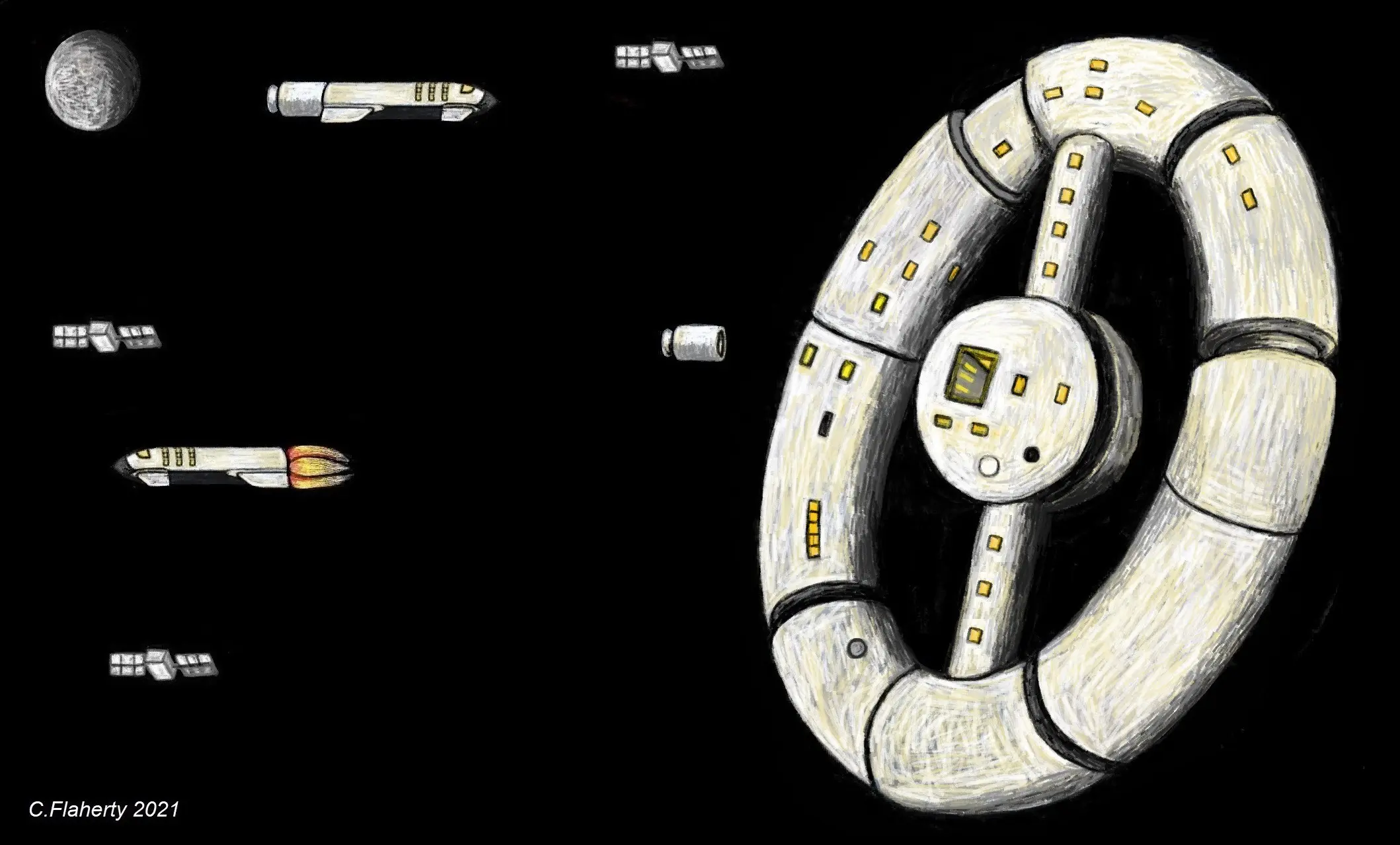
“▲ A Starship reduces speed, to dock with the DSDS1 ‘Valley Forge’. Satellites offer the first line of defence. In the background a Starship is propelled by a Drone Nuclear Propulsion Tug. Another Tug comes-in for refuelling.”
- REFERENCES
- • Air Force Association. 2020 Keynote-Fireside Chat Between Elon Musk and Lt Gen John F. Thompson. Air Warfare Symposium. Orlando, Florida (February 26-28).
• Betar, E. 2021 Future Operating Environment: Anti-Access and Area Denial in the Space Domain (Part 1). The Cove (24 June).
• Boushey, H.A. 1958 Lunar Base Vital. Army-Navy-Air Force Register. Number 79 (8 February).
• Bruger, S.J. 1995 Not Ready for the First Space War: What about the Second? Naval War College Review. Volume XLVIII. Number 1 (Winter).
• Crockett, J.W. 2012 Space Warfare in the Here and Now: The Rules of Engagement for U.S. Weaponized Satellites in the Current Legal Space Regime. Journal of Air Law and Commerce. Volume 77. Issue 4.
• David, L. 2007 China’s Anti-Satellite Test: Worrisome Debris Cloud Circles Earth. Space.com.
• Davis, M. 2021 ADF Space Command is the Right Next Step for Australian Space Power. The Strategist (5 May).
• Dolman, E.C. 2002 Astropolitik: Classical Geopolitics in the Space Age. Frank Cass.
• Erwin, S. 2021 U.S. Army Approves Plans for a Future Tactical Space Layer. Spacenews.
• Federation of American Scientists. 1997 VKS. Space Policy Project.
• Flaherty, C. 2021 The Jominian-Space Model. My Security Marketplace Website (30 March).
• Freeland, S. Chen, D.K-W. Jakhu, R.S. 2021 War in Space Would be a Catastrophe. A Return to Rules-Based Cooperation is the Only Way to Keep Space Peaceful.
• Gould, C.L. 1978 Large Scale Human Benefits from the Industrialization of Space. The Space Congress. Proceedings.
• Harrison, T. Johnson, K. Young, M. 2021 Defense Against the Dark Arts in Space: Protecting Space Systems from Counterspace Weapons. A Report of the CSIS Aerospace Security Project. Rowman & Littlefield (February).
• Havercroft, J. Duvall, R. 2009 The Geopolitics of Space Control and the Transformation of State Sovereignty. Bormann, N. Sheehan, M. (Editors) Securing Outer Space: International Relations Theory and the Politics of Space. Routledge Critical Security Studies.
• Janhunen, P. 2021 Terraforming the Dwarf Planet: Interconnected and Growable Ceres Megasatellite World. Elsevier (15 January).
• Joint Publication 3-14. 2018 [-2020] Space Operations. U.S. Department of Defense.
• Langton, C. 2007 Military Balance 2007 [The]. International Institute for Strategic Studies. Routledge.
• Maccone, C. Bussolino, L. 2002 The Trojan Asteroids as Bases to Monitor Other Asteroids Potentially Dangerous for Earth. Journal of the British Interplanetary Society. Volume 55.
• McGill. 2016 Manual on International Law Applicable to Military Uses of Outer Space (MILAMOS). McGill Centre for Research in Air and Space Law.
• Ministry of Defence [UK Government] 2021 Guidance: UK Space Command (April).
• NASA. 2021 What Is NASA’s Asteroid Redirect Mission? Fact Sheet.
• NASA. 2005 NASA Orbital Debris Program Office. Image, Photo Gallery. Debris-GEO1280.
• Neufeld, M.J. 2006 Space Superiority: Wernher Von Braun’s Campaign for a Nuclear-Armed Space Station, 1946–1956. Space Policy 22.
• Reesman, R. Wilson, J. 2021 Physics Gets A Vote: No Starcruisers For Space Force. War on the Rocks (28 June).
• Reesman, R. Wilson, J.R. 2020 The Physics of Space War: How Orbital Dynamics Constrain Space-to-Space Engagements. The Aerospace Corporation (October).
• Sambaluk, N.M. 2011 What’s a Heaven For? National Public Culture’s Role in Shaping U.S. Space Policy, Aerospace Doctrine, and the Future of the Dyna-Soar, 1957-61. Dissertation. The University of Kansas.
• Samson, V. 2021 Threats to Space Aren’t Just Weapons. TRENDS Research & Advisory (24 February).
• Spacewatch Global. 2020 Iran Unveils Military Space Command. New Details on Satellite Launch (22 April).
• Szymanski, P. 2019 Techniques for Great Power Space War. Strategic Studies Quarterly (Winter).
• Szmigiera, M. 2021 Countries with Highest Military Spending Worldwide in 2019. Statista.
• U.S. Space Force [Headquarters United States Space Force]. 2020 Space Capstone Publication. Spacepower (June).
• United Nations. Office for Outer Space Affairs (UNOOSA). Resolution Adopted by The General Assembly 2222 (XXI). Treaty on Principles Governing the Activities of States in the Exploration and Use of Outer Space, Including the Moon and Other Celestial Bodies.
• Yamaguchi, M. 2020 Japan Launches New Unit to Boost Defense in Space. Defense News (18 May).
AUTHOR
Chris Flaherty authored the Terrorism Research Center’s report – Dangerous Minds (2012). He was the co-primary author, along with Robert J. Bunker of the book – Body Cavity Bombers: The New Martyrs (iUniverse, 2013). Two essays of his, from 2003 and 2010 were reprinted in the Terrorism Research Center’s book – Fifth Dimensional Operations (iUniverse, 2014). He contributed a book chapter – The Role of CCTV in Terrorist TTPs, edited by Dave Dilegge, Robert J. Bunker, John P. Sullivan, and Alma Keshavarz, the book – Blood and Concrete: 21st Century Conflict in Urban Centers and Megacities, a Small Wars Journal anthology, published on behalf of the Small Wars Foundation with Xlibris (2019). Chris Flaherty is currently a Space & Defense Tech and Security News Regular Contributor.
CONTACT DETAILS: Dr Chris Flaherty https://au.linkedin.com/in/drchrisflaherty

